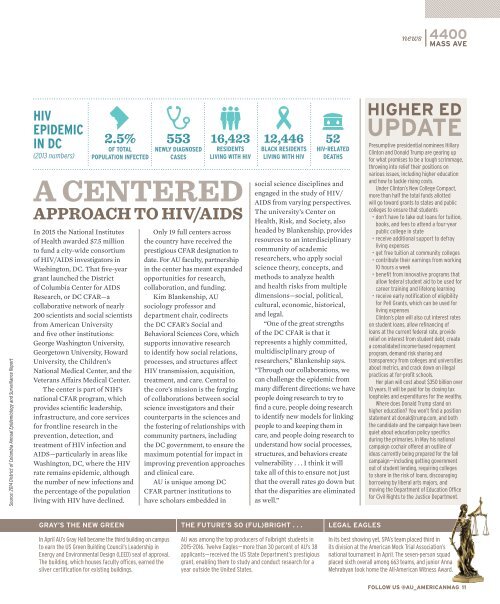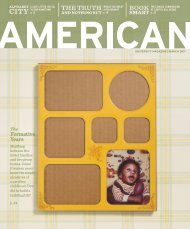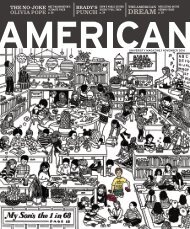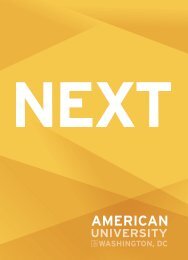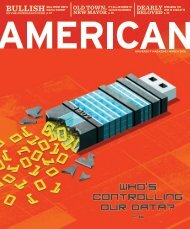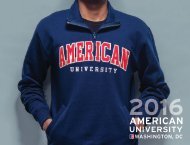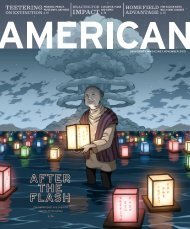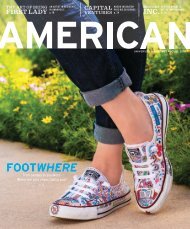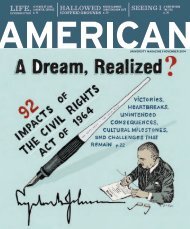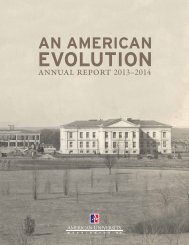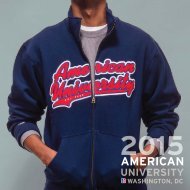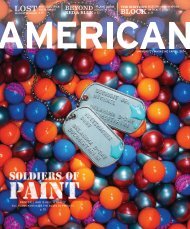American magazine, July 2016
In this issue explore DC street art, run away with the Street Light Circus, meet AU’s Olympic hopefuls, reminisce about commencements past, hop on the Metro to the Smithsonian, and get to know some of AU’s 1,875 Boston transplants. Also in the July issue: 3 minutes on the national parks, 88 years of yearbooks, and a beer quiz.
In this issue explore DC street art, run away with the Street Light Circus, meet AU’s Olympic hopefuls, reminisce about commencements past, hop on the Metro to the Smithsonian, and get to know some of AU’s 1,875 Boston transplants. Also in the July issue: 3 minutes on the national parks, 88 years of yearbooks, and a beer quiz.
You also want an ePaper? Increase the reach of your titles
YUMPU automatically turns print PDFs into web optimized ePapers that Google loves.
news<br />
Source: 2014 District of Columbia Annual Epidemiology and Surveillance Report<br />
HIV<br />
EPIDEMIC<br />
IN DC<br />
(2013 numbers)<br />
2.5%<br />
OF TOTAL<br />
POPULATION INFECTED<br />
In 2015 the National Institutes<br />
of Health awarded $7.5 million<br />
to fund a city-wide consortium<br />
of HIV/AIDS investigators in<br />
Washington, DC. That five-year<br />
grant launched the District<br />
of Columbia Center for AIDS<br />
Research, or DC CFAR—a<br />
collaborative network of nearly<br />
200 scientists and social scientists<br />
from <strong>American</strong> University<br />
and five other institutions:<br />
George Washington University,<br />
Georgetown University, Howard<br />
University, the Children’s<br />
National Medical Center, and the<br />
Veterans Affairs Medical Center.<br />
The center is part of NIH’s<br />
national CFAR program, which<br />
provides scientific leadership,<br />
infrastructure, and core services<br />
for frontline research in the<br />
prevention, detection, and<br />
treatment of HIV infection and<br />
AIDS—particularly in areas like<br />
Washington, DC, where the HIV<br />
rate remains epidemic, although<br />
the number of new infections and<br />
the percentage of the population<br />
living with HIV have declined.<br />
553<br />
NEWLY DIAGNOSED<br />
CASES<br />
16,423<br />
RESIDENTS<br />
LIVING WITH HIV<br />
Only 19 full centers across<br />
the country have received the<br />
prestigious CFAR designation to<br />
date. For AU faculty, partnership<br />
in the center has meant expanded<br />
opportunities for research,<br />
collaboration, and funding.<br />
Kim Blankenship, AU<br />
sociology professor and<br />
department chair, codirects<br />
the DC CFAR’s Social and<br />
Behavioral Sciences Core, which<br />
supports innovative research<br />
to identify how social relations,<br />
processes, and structures affect<br />
HIV transmission, acquisition,<br />
treatment, and care. Central to<br />
the core’s mission is the forging<br />
of collaborations between social<br />
science investigators and their<br />
counterparts in the sciences and<br />
the fostering of relationships with<br />
community partners, including<br />
the DC government, to ensure the<br />
maximum potential for impact in<br />
improving prevention approaches<br />
and clinical care.<br />
AU is unique among DC<br />
CFAR partner institutions to<br />
have scholars embedded in<br />
12,446<br />
BLACK RESIDENTS<br />
LIVING WITH HIV<br />
52<br />
HIV-RELATED<br />
DEATHS<br />
social science disciplines and<br />
engaged in the study of HIV/<br />
AIDS from varying perspectives.<br />
The university’s Center on<br />
Health, Risk, and Society, also<br />
headed by Blankenship, provides<br />
resources to an interdisciplinary<br />
community of academic<br />
researchers, who apply social<br />
science theory, concepts, and<br />
methods to analyze health<br />
and health risks from multiple<br />
dimensions—social, political,<br />
cultural, economic, historical,<br />
and legal.<br />
“One of the great strengths<br />
of the DC CFAR is that it<br />
represents a highly committed,<br />
multidisciplinary group of<br />
researchers,” Blankenship says.<br />
“Through our collaborations, we<br />
can challenge the epidemic from<br />
many different directions: we have<br />
people doing research to try to<br />
find a cure, people doing research<br />
to identify new models for linking<br />
people to and keeping them in<br />
care, and people doing research to<br />
understand how social processes,<br />
structures, and behaviors create<br />
vulnerability . . . I think it will<br />
take all of this to ensure not just<br />
that the overall rates go down but<br />
that the disparities are eliminated<br />
as well.”<br />
Presumptive presidential nominees Hillary<br />
Clinton and Donald Trump are gearing up<br />
for what promises to be a tough scrimmage,<br />
throwing into relief their positions on<br />
various issues, including higher education<br />
and how to tackle rising costs.<br />
Under Clinton’s New College Compact,<br />
more than half the total funds allotted<br />
will go toward grants to states and public<br />
colleges to ensure that students<br />
• don’t have to take out loans for tuition,<br />
books, and fees to attend a four-year<br />
public college in state<br />
• receive additional support to defray<br />
living expenses<br />
• get free tuition at community colleges<br />
• contribute their earnings from working<br />
10 hours a week<br />
• benefit from innovative programs that<br />
allow federal student aid to be used for<br />
career training and lifelong learning<br />
• receive early notification of eligibility<br />
for Pell Grants, which can be used for<br />
living expenses<br />
Clinton’s plan will also cut interest rates<br />
on student loans, allow refinancing of<br />
loans at the current federal rate, provide<br />
relief on interest from student debt, create<br />
a consolidated income-based repayment<br />
program, demand risk sharing and<br />
transparency from colleges and universities<br />
about metrics, and crack down on illegal<br />
practices at for-profit schools.<br />
Her plan will cost about $350 billion over<br />
10 years. It will be paid for by closing tax<br />
loopholes and expenditures for the wealthy.<br />
Where does Donald Trump stand on<br />
higher education? You won’t find a position<br />
statement at donaldjtrump.com, and both<br />
the candidate and the campaign have been<br />
quiet about education policy specifics<br />
during the primaries. In May his national<br />
campaign cochair offered an outline of<br />
ideas currently being prepared for the fall<br />
campaign—including getting government<br />
out of student lending, requiring colleges<br />
to share in the risk of loans, discouraging<br />
borrowing by liberal arts majors, and<br />
moving the Department of Education Office<br />
for Civil Rights to the Justice Department.<br />
GRAY’S THE NEW GREEN<br />
In April AU’s Gray Hall became the third building on campus<br />
to earn the US Green Building Council’s Leadership in<br />
Energy and Environmental Design (LEED) seal of approval.<br />
The building, which houses faculty offices, earned the<br />
silver certification for existing buildings.<br />
THE FUTURE’S SO (FUL)BRIGHT . . .<br />
AU was among the top producers of Fulbright students in<br />
2015–<strong>2016</strong>. Twelve Eagles—more than 30 percent of AU’s 38<br />
applicants—received the US State Department’s prestigious<br />
grant, enabling them to study and conduct research for a<br />
year outside the United States.<br />
LEGAL EAGLES<br />
In its best showing yet, SPA’s team placed third in<br />
its division at the <strong>American</strong> Mock Trial Association’s<br />
national tournament in April. The seven-person squad<br />
placed sixth overall among 663 teams, and junior Anna<br />
Mehrabyan took home the All-<strong>American</strong> Witness Award.<br />
FOLLOW US @AU_AMERICANMAG 11


